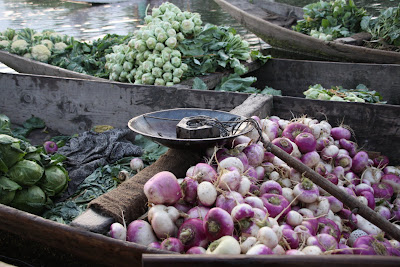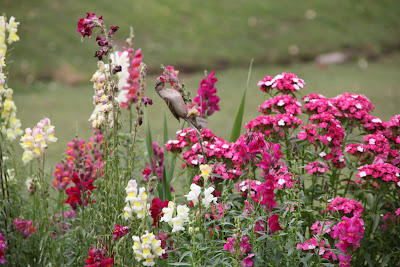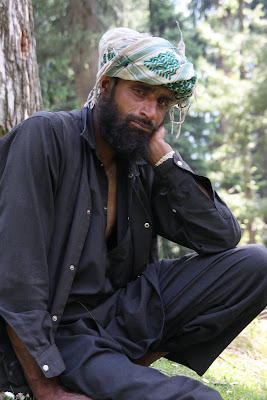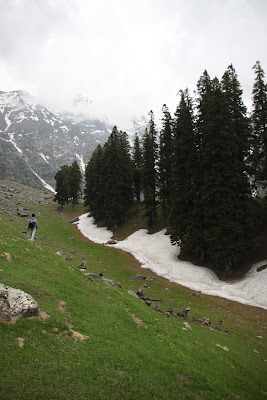Jammu& Kashmir has a rich and ancient history intertwined with the great Hindu epics and with the Gods themselves, however, in more recent times, the state has fallen under the rule of the Maharajahs and Sikhs of India, the Mughals, and the Afghans. I was awestruck by the stunning features of its people, almost mirroring the land’s history. Particularly fascinating was their strong resemblance to the Afghan people in both appearance and dress. The architecture is also a peculiar and beautiful fusion of these different cultures incorporating some adaptations to climate and terrain. Kashmir had stolen my heart the moment I landed.
As we drove through the streets of Srinagar to the Dal Lake, I noticed many of the homes mirrored the styles of those found in the mountainous regions of Europe with the exception of their tin roofs. Similar to Kerala, Kashmir is known for its houseboat culture, born in the 1800s when Indian Civil Service members who vacationed in the city in the summers designed and resorted to houseboats when the local government did not permit them to build permanent homes. There are now over 500 houseboats along the Jhelum River flowing into the Dal Lake, and mine was named The Pakhtoon.
The scene and mood are soothing when being paddled on one of the many “taxi” paddle boats known as shikaras from the mainland across the lake to reach the houseboats. The Dal Lake is cushioned in the Kashmir Valley and surrounded by mountains with Mughal gardens, palaces, and ancient Hindu temples perched along their slopes. Shikaras of vibrant reds, blues, yellows, and oranges ornament its lotus petal-covered waters, transporting tourists and locals to and fro. The townships built on these waters are an intriguing display. The men are either merchants or boat paddlers, and the women farm the lands to produce vegetables for household consumption or for daily sales in the early morning vegetable market- a fascinating exchange or selling of the produce between wholesalers, farmers, and individual buyers from their boats. Whether observing this placidity from my houseboat veranda or gliding through the townships on a shikara, for me, the experiences were some of bliss and otherworldliness.
 Shikaras or water taxis of Srinagar
Shikaras or water taxis of Srinagar
 Child dressed in Kashmiri traditional clothing
Child dressed in Kashmiri traditional clothing
 Kashmiri women shyly turning their faces away
Kashmiri women shyly turning their faces away
 Typical Kashmiri houseboat
Typical Kashmiri houseboat
 Traditional Kashmiri dress, typical in the winter season and weddings
Traditional Kashmiri dress, typical in the winter season and weddings
 Hundreds year old traditional homes along River Jhelum's banks
Hundreds year old traditional homes along River Jhelum's banks
 Sheeshah or hookah pipes with clay bases
Sheeshah or hookah pipes with clay bases
 Buying and selling at the Dal Lake vegetable market
Buying and selling at the Dal Lake vegetable market
 Waiting for customers
Waiting for customers
 Care for some fresh lettuce?
Care for some fresh lettuce?
 Talk about fresh produce
Talk about fresh produce
 And, talk about drive thru service!
And, talk about drive thru service!
 After an hour, the market comes to an end
After an hour, the market comes to an end
Given the limitations on livelihood activities that the harsh winters cause as well as the historical inaccessibility of Kashmir Valley that made trade a challenge, the state became, as author Dr. Paramjit Singh Jaiswal puts it, “a crucible of innovation where diverse ideas rubbed shoulders and threw up an altogether new concept of art, architecture, and craftsmanship…the entrepreneurial traders had to identify tradable items that were small and light and having intricacy and high sales value which were transportable on narrow, serpentine, steep mountain paths to the plains.” Architectural designs of domes and embroidery skills from Samarkand, the concept of minars and calligraphy from Persia, and carpet weaving and intricate painting styles developed within Kashmir have resulted in some of the most irresistibly charming handicrafts. Gorgeous paper mache vases, silk carpets, intricately carved wooden items, and elaborately embroidered scarves reflecting the colorful and abundant fruits and flowers covering the landscape are just some of the treasures I favored. After hours long negotiations turned into humorous chats with the merchants, I soon realized that the actual purchasing was such a tiny part of the entire shopping experience in Kashmir. The hospitable nature of the people nurtured hours of comedic chit chat over cup after cup of chai or Kehavah, a rich brew of saffron, cardamom, cinnamon, sugar, and green tea. On one occasion, it led to a full feast of rice, tandoori chicken, spiced lamb kebabs, juicy lamb meatballs, and lamb cooked in a saffron and yoghurt sauce.
 Carpet weaving at home, a traditional livelihood
Carpet weaving at home, a traditional livelihood
 Carpet weaver with his children
Carpet weaver with his children
Mughal gardens and palaces are in abundance throughout the state. In the 1600s, Jahangir commissioned the construction of the Shalimar gardens for his wife Nur Jahan, and he and his successors subsequently commissioned the Pari Mahal (the palace of the fairies), Nishat Bagh (the garden of spring), and Naseem Bagh that continue to flourish with the most colorful array of flora amidst stunning fountains, serving the dual purpose of providing air flow during the summer seasons. The words of Perisan poet Jami are inscribed on the walls of the gardens, "If there is paradise on earth, it is this, it is this, it is this." The typical Mughal architectural styles were often modified to sustain the heavy snowfall of the winters, and large domes, especially on mosques, were replaced by tall, sharply-inclined spires made of wood. Many of the mosques, including the 14th century Dargah Dastageer Sahab, somewhat resemble even the pagoda styles of China.
 Little worshipper
Little worshipper
 Unique Islamic architecture of Kashmir
Unique Islamic architecture of Kashmir
 Green, the color of peace for Muslims
Green, the color of peace for Muslims
 Original wood panels of the mosque
Original wood panels of the mosque
 Entrance to the Dargah
Entrance to the Dargah
 Gardener at the Nishat Bagh, one of the Mughal gardens
Gardener at the Nishat Bagh, one of the Mughal gardens
 Pari Mahal, palace of the fairies
Pari Mahal, palace of the fairies
 Entrance to the Pari Mahal
Entrance to the Pari Mahal
 Are these daffodils?
Are these daffodils?
 Bird drinking the sap from the flowers
Bird drinking the sap from the flowers
 A view of the lake from the gardens
A view of the lake from the gardens
 Fountains of Nishat Bagh
Fountains of Nishat Bagh
 As one ascends the pavilions become more grand, reserved for minister and finally for the king and queen
As one ascends the pavilions become more grand, reserved for minister and finally for the king and queen
 The grandest pavilion of all, the Royal Pavilion
The grandest pavilion of all, the Royal Pavilion
Outside of Srinagar and past its saffron fields, there are many hill resorts lush with pine, poplar, and fir trees, the most notable being Sonmarg and Gulmarg. The latter, originally called Gaurimarg by the shepherd folk, is especially attractive because of the variety of wild flowers that bloom here. It was ostensibly frequented by Emperor Jehangir who is said to have collected 21 different varieties of these. Gulmarg is frequented primarily by domestic tourists for pony-riding through its hills, which I ended up doing, as well as riding up the gondola that takes visitors high up onto the mountain tops of Khilanmarg. Remnants of the winter’s snowfall covered the trees and slopes even during my visit in May.
Most beautiful of all, however, is Pahalgam, at an altitude of 2,130 meters. When my eyes first sighted this hidden gem, I was awestruck, and I finally understood why Kashmir was called the Land of the Gods by the ancient Hindu people. Everest’s babies stud its landscape while the Aru and Sheshnag Rivers from the Himalayas flow down the mountainsides as waterfalls and through the town as the Lidder River. Here too, pine trees line the slopes of the snow-capped mountains. Pahalgam offers some of the best trekking and most stunning views in the world. During a brief, two day trek to Tulyan, while I was disappointed that the snow hadn’t melted enough for us to pass through its mountains to reach the stunning Tulyan Lake, I was still captivated by the charms of the Baisaran, Daban (gypsy), and Pahalgam valleys and its mysterious gypsy people.
Pahalgam was a small shepherd village until it expanded into a tourist destination. Three gypsy groups continue to inhabit these regions, typically maintaining two settlements per tribe- one high up in the mountains during the summer and a second in the plains during the harsh winters. The Pahal (shepherds), Gogar (local gypsies), and the Bakarwal (traveler gypsies) all rely heavily on livestock for their income and can be seen traversing the hills and mountains of Pahalgam with their herds of goat and sheep. While they tend to speak local dialects and Kashmiri, many are conversant in Urdu, and to converse with them in my broken Hindi/Urdu resulted in a personally remarkable connection that I will cherish forever. The one common set of questions I was asked by gypsies and city Kashmiris alike was around their intrigue to see an “Indian” woman traveling alone. Was I not scared? Was I not married? Had I really been traveling all alone? I amusingly responded that I was amidst them after all, so had I any reason to fear? Smiling and laughing, they agreed and said that I am, after all, a part of their family and always had a home amongst them.
Pahalgam was a small shepherd village until it expanded into a tourist destination. Three gypsy groups continue to inhabit these regions, typically maintaining two settlements per tribe- one high up in the mountains during the summer and a second in the plains during the harsh winters. The Pahal (shepherds), Gogar (local gypsies), and the Bakarwal (traveler gypsies) all rely heavily on livestock for their income and can be seen traversing the hills and mountains of Pahalgam with their herds of goat and sheep. While they tend to speak local dialects and Kashmiri, many are conversant in Urdu, and to converse with them in my broken Hindi/Urdu resulted in a personally remarkable connection that I will cherish forever. The one common set of questions I was asked by gypsies and city Kashmiris alike was around their intrigue to see an “Indian” woman traveling alone. Was I not scared? Was I not married? Had I really been traveling all alone? I amusingly responded that I was amidst them after all, so had I any reason to fear? Smiling and laughing, they agreed and said that I am, after all, a part of their family and always had a home amongst them.
 Gypsy man
Gypsy man
 Gypsy woman
Gypsy woman
 And their gypsy baby
And their gypsy baby
 Gypsy temporary settlement enroute to their summer settlement
Gypsy temporary settlement enroute to their summer settlement
 Father with child
Father with child
 Woman with her children
Woman with her children
 I loved the gorgeous nose studs!
I loved the gorgeous nose studs!
 Perhaps, the grandmother?
Perhaps, the grandmother?
 Hospitable and charming people
Hospitable and charming people
 Pahalgam's nature
Pahalgam's nature
 My trekking guide and tea stallers- chai break!
My trekking guide and tea stallers- chai break!
 Wood for cooking and warmth
Wood for cooking and warmth
 Pine trees of Pahalgam
Pine trees of Pahalgam
 Goat shepherd trying to nap
Goat shepherd trying to nap
 Wood collectors
Wood collectors
 Now, I miss my Amma!
Now, I miss my Amma!
 Trekking up that moutain to Tulyan Valley- no small feat!
Trekking up that moutain to Tulyan Valley- no small feat!
 Homestead of a gypsy family
Homestead of a gypsy family
 Simple and happy living
Simple and happy living
 Another chai break! My favorite pastime! This time with sheep's milk!
Another chai break! My favorite pastime! This time with sheep's milk!
 Onwards we go...almost there!
Onwards we go...almost there!
 Stunning mountain ranges of Pahalgam Valley
Stunning mountain ranges of Pahalgam Valley
 Tulyan Valley just over these mountains
Tulyan Valley just over these mountains
 Tulyan Valley- Incredible!
Tulyan Valley- Incredible!
 Formidable snow did not give us way to the stunning Tulyan Lake- next time!
Formidable snow did not give us way to the stunning Tulyan Lake- next time!
 Gypsy woman taking the "kids" to their summer settlement
Gypsy woman taking the "kids" to their summer settlement
Kashmir is a magical place that not only stirred my imagination but often materialized these into unforgettable experiences. I deeply hope to return in the near future. On his deathbed, it is believed that when Emperor Jahangir was asked about his cherished desire, he responded, “Kashmir, the rest is worthless.”
Stay tuned for the post “Land of the Gods,” which will describe the Hindu sites I was fortunate to visit on my last day in the state.


















No comments:
Post a Comment